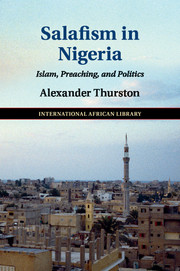Book contents
- Frontmatter
- Contents
- Acknowledgments
- List of Maps
- Introduction: Defining Salafism, Analyzing Canons
- Part I Salafism and Its Transmission
- Part II The Canon in Action
- Part III Boko Haram and the Canon
- Conclusion
- Appendix 1 The Sermon of Necessity (Khuṭbat al-Ḥāja)
- Glossary of Persons
- Glossary of Arabic Terms
- Bibliography
- Index
- Miscellaneous Endmatter
Introduction: Defining Salafism, Analyzing Canons
Published online by Cambridge University Press: 05 September 2016
- Frontmatter
- Contents
- Acknowledgments
- List of Maps
- Introduction: Defining Salafism, Analyzing Canons
- Part I Salafism and Its Transmission
- Part II The Canon in Action
- Part III Boko Haram and the Canon
- Conclusion
- Appendix 1 The Sermon of Necessity (Khuṭbat al-Ḥāja)
- Glossary of Persons
- Glossary of Arabic Terms
- Bibliography
- Index
- Miscellaneous Endmatter
Summary
This book examines the interaction between two important forces on the world stage: Nigeria, the most populous country in Africa, and Salafism, a loosely organized community of Muslim activists who claim that they alone incarnate the practices and beliefs of the earliest Muslims. In northern Nigeria, a majority-Muslim region, Salafis have become prominent as preachers, media stars, and allies of certain elected politicians. These Salafis challenge the religious dominance of hereditary Muslim rulers and Sufi shaykhs by advancing a largely textualist model of religious authority. This book provides insight into how Nigerian Muslims are negotiating their relationships with one another and with the contemporary Middle East – especially Saudi Arabia, where Salafism receives political and institutional support. At the same time, the trajectory of Salafism in northern Nigeria sheds light on the stages through which the global Salafi movement has passed. Salafis around the world, even in non-Arab lands, have come to invoke a set of Arabic texts and a group of twentieth-century Middle Eastern thinkers as standards of authority in local struggles over who gets to speak for Islam. Examining Salafism in Nigeria illustrates how references to core texts can reflect membership in religious communities – and how such references provide a key tool for understanding the many geographically dispersed, decentralized religious activist networks that are helping to shape the world today.
On the basis of fieldwork in Nigeria and a historical study of the formation of Salafism, I argue that Salafism is embodied in and transmitted through a canon, a communally negotiated set of texts that is governed by rules of interpretation and appropriation. Salafis invoke the canon to spread Salafism but also to police the boundaries of Salafism. The idea of a Salafi canon is implicit, although underdeveloped, in some previous work on Salafism; here I make it the explicit theoretical frame for analysis, examining how the canon formed and how it is disseminated.
This understanding of Salafism challenges widespread Western depictions of Salafism as a one-dimensional and “literalist” school of interpreting the Qurʾan and the Sunna (the authoritative tradition of the Prophet Muḥammad, as preserved in reports of his words and deeds, reports known as aḥādīth in the plural and ḥadīth in the singular).
- Type
- Chapter
- Information
- Salafism in NigeriaIslam, Preaching, and Politics, pp. 1 - 28Publisher: Cambridge University PressPrint publication year: 2016

